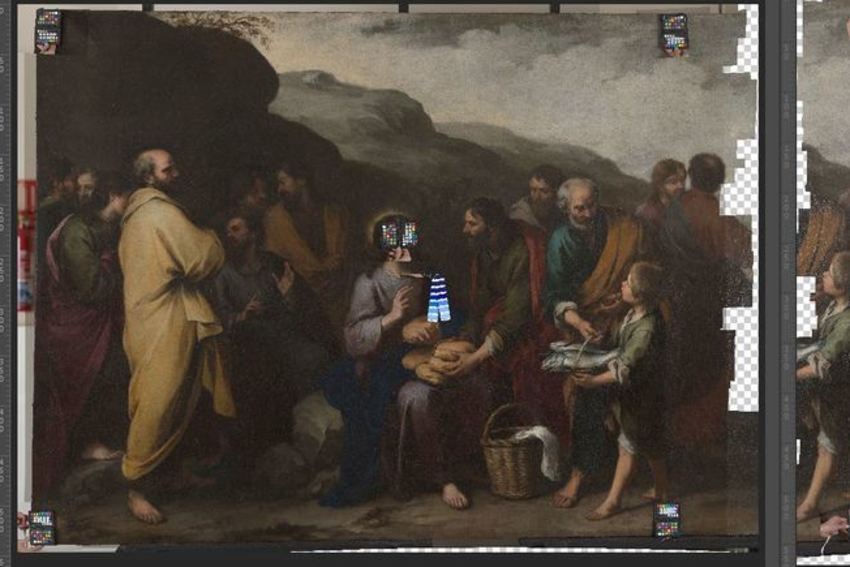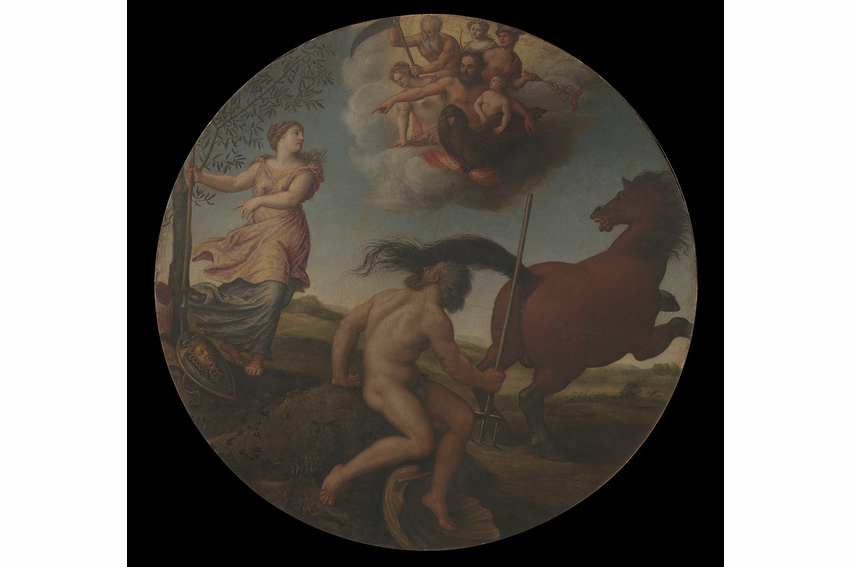
Checking colour between two different prints for Boucher's 'Sketch for a Portrait of Madame de Pompadour' – note the slight difference between the left-hand and right-hand images © Factum Foundation
In order to capture both accurate and high-resolution colour of a flat or gently curved surface such as painting or a mural, we employ a specialist version of the technique known as panoramic photography. Many people are familiar with the basic concept from landscape photography, where overlapping photos of a view are stitched together to create sweeping panoramic images. Factum, however, uses panoramic photography in such a way as to produce images of cultural heritage objects with resolutions of up to 900 dpi that also comprise accurate colour information. It is this kind of image that is useful for studying the detail of a painted surface. This is particularly true if the colour is merged with 3D data from the Lucida 3D Laser Scanner for example. The colour data can also be printed onto different media as part of the process of creating a facsimile – if the print is directly compared to the original painting, the colour should look identical.
Panoramic photography for cultural heritage imaging
Overlapping, high-resolution images of the surface of the artwork are taken from a single (static) point using a telephoto lens. In post-processing, the photographs are stitched together with the free software PTGui to create a single large image file. PTGui is used to correct geometric distortions arising from the fact that the camera is usually positioned in front of the middle of the painting, whose corners are therefore further away from the lens than the centre. Such distortion can be corrected by carefully mapping the colour onto a scaled 3D model to create a layered archive of information.
During a recording, the photographer follows a set procedure to ensure the accuracy of the colour data, or in other words, how ‘true to life’ it is. Flashes are used to evenly illuminate the surface of an artwork, although their configuration differs depending on the specific characteristics of the surface being photographed. The photographer also takes a number of photos of the artwork which incorporate an X-Rite ColorChecker Passport, which contains colour swatches with known RGB values. During post-processing, these photos are used to correct and unify the colour across the individual, overlapping photographs taken in the recording. The colour checker images are also used to correct differences in the way the light falls across the surface.
The following images show the process followed during imaging in order to obtain accurate colour in the final panorama:

Measuring the light before setting camera paramaters for the imaging of Boucher's 'Madame de Pompadour' © Factum Foundation

During a recording, an X-Rite colour checker will be photographed next to the painting for digital colour management during post-processing © Factum Foundation
Processing the images
The images taken during a recording are joinged together into a single panorama using the software PTGui, which locates matching pixels accross overlapping photographs. The panorama of the painting shown in the image below is composed of 672 individual photographs.

Screenshot from PTGui showing the individual images that make up this panorama of The Miracle of the Fish and Bread by Bartolomé Esteban Murillo © Factum Foundation
Only the central part of each image taken during the recording is in focus and is used by PTGui to produce the high-resolution panorama.

Only the area demarcated by red lines is in focus and used by the software to create the panorama as in this detail from Moses Drawing Water from the Rock by Bartolomé Esteban Murillo © Factum Foundation
The panorama created in PTGui is distorted towards the corners because of the camera positioning during imaging: the camera is further away from the corners than the centre. The distortions will be corrected when the colour data is mapped onto the 3D data.

The distorted panorama must be rectified using 3D data © Factum Foundation

The colour (left-hand image) is mapped onto the 3D (right-hand image) to rectify the distortions produced by the panoramic photography process. This also produces a layered archive of information – this is a screenshot from our layered archive for Boucher's Sketch for a Portrait of Madame de Pompadour © Factum Foundation
The colour is corrected using digital colour management methods. The images of the colour checker – one at each corner of the painting, one in the centre – are also used to rectify any differences in the way the light falls accross the surface of a painting.

Colour checkers photographed for digital colour checking. Pantone sticks for later physical colour checking © Factum Foundation

The colour checker images – one at each of the four corners and a fifth image in the centre – are used to ensure that light and colour are accurate accross an image © Factum Foundation
Although digital colour management produces files that closely correspond to the original colour of a painting, Factum Foundation also implements ‘physical’ colour correction methods as an extra form of quality control. These usually involve matching Pantone colour swatches to different colours on the painting. Where possible, printed samples of the facsimile are compared to the original during the process of re-materialising the work. Both methods usually result in a slight adjustment of the digital file prior to a final printing run.









